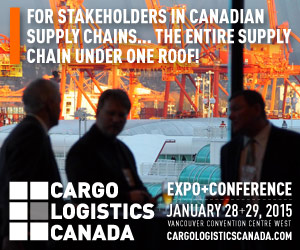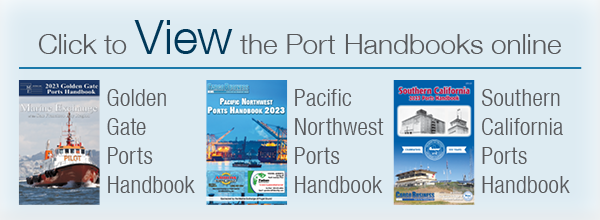|
By Peter Hurme
In late September, I was one of almost 25 million travelers in one of 10 million vehicles that will have crossed the Pacific region border between the U.S. and Canada this year.
However, that’s just the start.
The U.S. and Canada enjoy over $700 billion in bilateral trade in goods and services annually, in addition to $600 billion in direct investment on both sides of the border, with Canada the top export market for 34 U.S. states, according to Canadian and U.S. trade statistics.
Canada’s Border Services Agency documented almost two million commercial releases through the Pacific region border in 2013.
There is global freight passing between these next-door neighbors in the form of imports that originated from Asia Pacific countries like China, entering Western Canada’s seaports destined for markets in the U.S.
Beyond the Border
In an age of increased scrutiny since the terrorist attacks on the U.S. on Sept. 11, 2001, the balance between streamlining freight movement and instigating appropriate safety controls has proven to be a real balancing act.
In 2011, Prime Minister Stephen Harper of Canada and U.S. President Barack Obama announced Beyond the Border: A Shared Vision for Perimeter Security and Economic Competitiveness. The purpose of the Beyond the Border plan was to establish a long-term partnership on what the two leaders said would be a "perimeter approach to security and economic competitiveness…not just at the border, but beyond the border to enhance our security and accelerate the legitimate flow of people, goods and services."
The series of Beyond the Border initiatives includes the Trusted Trader pilot program, Authorized Economic Operator programs, and the pre-inspection pilot programs in Blaine, Wash., Vancouver, BC, and Buffalo, New York.
The pre-inspection pilot’s aim is to inspect cargo in Canada in order to expedite on the U.S. side, with the mantra of "inspect once, clear twice," for containerized and other cargo arriving at the Western Canadian port of Prince Rupert that is loaded onto Canadian National intermodal trains destined for the U.S.
U.S. and Canadian border officials spoke about the potential advancement of perimeter screening on a recent tour that CBN took part in for press, public, and private entities from the U.S.
An additional digit on ocean-going intermodal rail containers could allow for joint U.S.-Canadian Customs screening of data three days or more before the box landed at a Canadian seaport, they said.
One example could be to identify high-risk agricultural products that would not be allowed into the U.S. The U.S. refused entry to over 20 percent of ag shipments last year, according to officials.
Another related development is the Canadian National Railroad, currently completing the construction of a fumigation facility near Canada’s border with Minnesota, which will staff U.S. animal health and plant inspectors on site.
What might also come into play with regard to U.S.-Canadian trade is a much broader, ambitious U.S. project called the International Trade Data System (ITDS) ─ planned for the end of 2016 ─ which promises a paperless "single window" access point, per an executive order President Obama signed earlier this year.
The ITDS would connect international traders with U.S. Customs and 47 different U.S. government agencies, greatly speeding up processing and regulatory approval. Currently, to clear imported or exported goods, users must submit a variety of mostly paper documents to a number of federal agencies, often taking days as opposed to what could, ostensibly, become minutes with the new system.
"This change will be particularly meaningful to our small- and medium-sized customers that depend on global trade to grow their businesses and reach the 95 percent of consumers that live outside U.S. borders," said Scott Davis, chairman and CEO of UPS.
In the meantime, while the Beyond the Border program appears to be in its infancy, after a recent tour of the U.S.-Canadian border, Customs and Border Protection Commissioner Gil Kerlikowske was cautiously optimistic when he said "a lot of good things have come out of the pre-inspection pilots already…but we don't want to take a victory lap right now. We want to proceed carefully and make sure we are getting this right."
Prince Rupert to Chicago, Memphis
One seaport in British Columbia in particular—the Port of Prince Rupert—is handling global freight from Asia that crosses the border to U.S. intermodal distribution hubs like Chicago and Memphis.
Flying out of Vancouver International Airport up to Prince Rupert is an experience. For great distances, all you see below is beautiful, remote forest lands, followed by the sudden looming of colorful canes at the container terminal after your arrival and ferry ride into the town of Prince Rupert.
Those cranes, standing amid a backdrop of alpine beauty, have been working containerships since September of 2007. That’s when the previously non-containerized Port of Prince Rupert, along with partners Canadian National, Railway, Maher Terminals, and China Ocean Shipping Company and additional funding from Canadian federal and provincial governments, opened the $170 million Fairview container terminal with initial capacity for 500,000 TEUs.
The Prince Rupert port is certainly not just for containers, with its significant grain and coal terminals and potential for LNG. However, it’s those metal boxes that go direct to CN’s on-dock rail, shooting across the Canadian prairies towards Chicago and beyond, which have been the source of much discussion by their American counterparts – particularly the two big seaports just the other side of the border in Seattle and Tacoma.
In 2013, Washington State’s two senators, Patty Murray and Maria Cantwell, came out against the U.S. Harbor Maintenance Tax (HMT) paid by U.S. shippers. It ostensibly helps provide for harbor maintenance and dredging, but has come under fire for not living up to that billing with a sizable annual surplus and a relatively small percentage used for its stated mandate.
The two Puget Sound ports have been calling for HMT reform for many years, worried over what they see as unfair competition from Western Canada’s ports ─ whereby cargo owners can effectively skirt the HMT and bring their international freight down into the U.S.
"Among the 25 largest North American ports, the fastest growing in 2012 were the Port of Prince
|

Rupert in Canada and the Port of Lazaro Cardenas in Mexico. Instead of U.S.-bound cargo creating economic growth here at home by entering at U.S. ports, we are witnessing it being diverted through Canadian and Mexican ports," the senators wrote in a letter to President Obama.
The two senators consequently unveiled their proposal, termed the Maritime Goods Movement Act for the 21st Century, which would replace the HMT and include a user fee for cargo coming over the border from Canada into the U.S., among several other initiatives.
In April at the NAFTANEXT Conference in Chicago, Canada’s ambassador to the U.S., Gary Doer, told the audience such a user fee would merely create more border and supply chain disruption.
"Thankfully, the proposal hasn’t gone anywhere," he said.
While the HMT debate continues, Prince Rupert continues to plan for containerized expansion to reach a 1.35 million-TEU capacity, according to Mark Schepp, vice president and general manager of Maher Terminals, Canada, a subsidiary of its New Jersey-based parent company.
With its current 750,000-TEU designed capacity, Canadian National’s intermodal rail operation at Prince Rupert is "operating at 30-35 percent capacity," Schepp said in September. The terminal is on pace to do 340,000 TEUs this year, he said.
However, it’s not as though Prince Rupert’s container business hasn’t been challenged. Schepp noted the ongoing U.S. West Coast employer-longshore contract negotiations have produced "a surge in business from the West Coast labor situation" due to cargo diversions from concerned shippers.
"The CN, or any railroad, can’t turn on a switch to deploy additional assets – they need lead time," said Schepp with regard to the flood of diverted cargo.
Canada’s own cargo surge
The CN and Canadian Pacific railroads have experienced a cargo surge of a different type that has stressed their respective networks.
A record crop year for Canada’s grain – up 27 percent from the previous year - combined with one of the worst winters in 60 years, created a logjam on rail capacity. Ultimately the Canadian government stepped in and enforced weekly service level minimums of approximately 1 million tons per week for grain shipments, where hefty fines could be imposed for falling below quota.
The government’s mandate "has, for the most part, been realistic service levels for us," said Mike LoVechhio, director of government of affairs for the CP in September.
A gateway for Asia
Regional freight mobility has been a major focus of both public and private Canadian stakeholders, especially with regard to Canada’s connection to its robust commerce with Asia.
The Asia Pacific Gateway Corridor Initiative was launched in 2006 to enhance Canada’s transportation and supply chain networks connected to Asia Pacific trade.
Canada’s federal government has invested $1.4 billion of what amounts to $9 billion invested between various public-private partnerships in road, rail, and terminal infrastructure projects. The busiest Canadian port – Port Metro Vancouver – is right in the middle of it all.
The port handled 2.8 million TEUs last year, making it the third-busiest port on North America’s West Coast behind Los Angeles and Long Beach, and it’s planning for another 4 million TEUs’ worth of capacity for the coming years.
The port and federal government recently announced the completion of the $45 million Roberts Bank project, consisting of a two-lane overpass that will provide grade separation between rail tracks and the Roberts Bank Causeway access road, adjacent to the Deltaport Container Terminal.
"The Deltaport Terminal, Road and Rail Improvement Project at Roberts Bank is increasing the efficiency of the Deltaport terminal so that it can better handle growing demand for container trade to and from Asia," said Robin Silvester, president and chief executive officer, Port Metro Vancouver.
The project is said to create an estimated 150,000 to 200,000 TEUs’ worth of additional annual capacity at Deltaport.
Trucking travails lead to reform
Capacity is not the only issue at hand for Vancouver BC’s port, since issues with the trucking sector that services the marine terminals there came to a head in March, when a 28-day trucker strike was triggered by the undercutting of per-container driver pay rates, along with a glut of trucks chasing available business.
In the wake of the March meltdown, late last month Canada’s Transportation Minister Todd Stone created an independent port container-trucking commissioner position, which would crack down on the practice of undercutting per-container driver pay rates and resolve related trucker disputes at Port Metro Vancouver.
"Job No. 1 for the new commissioner of the container trucking office will be to ensure full and complete compliance with rates negotiated in good faith with truckers back in March," Stone said.
Drivers were supposed to receive an immediate 12 percent hike in per-container rates as part of a settlement of the 28-day strike by more than 2,000 drivers. But Stone said not all companies are paying the new rates, an issue that was threatening to set off another work stoppage.
The move follows Port Metro Vancouver’s announcement that it intends to scrap its old licensing system for trucks allowed to pick up and deliver shipping containers at the port’s four terminals and replace it with a new system aimed at reducing the overall fleet by 25 to 40 percent.
One of the groups that represent port truck drivers was hopeful about the provincial legislation, but a spokesman told the Vancouver Sun that it is just a start in terms of reaching a permanent resolution.
"Today, I’m not going to make a comment that I think the (new) licensing system will fix everything," said Scott Doherty, assistant to the president of Unifor, who was speaking on behalf of the Unifor Vancouver Container Truckers’ Association.
|




